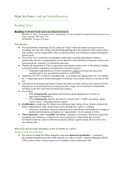89
Week Ten Notes: Land and Natural Resources
_________________________________________________
Reading Notes
Reading 1: World Trade and Late Industrialization
SOURCE: S. Moyo, P. Jha and P. Yeros, “Introduction” in The Scramble for Land and Natural Resources in
Africa, Springer (2015) pp. 3-30
SUMMARY: 26 pages to 6 pages
Introduction
● The transnational competition for the control of Africa’s land and natural resources has been
escalating since the early 2000s. Increased land grabbing drew the attention of key media, policy
and academic circles around 2008, when world food deficits and food prices spiked and popular
protests grew
● This recent wave of primitive accumulation shifts land ownership and property relations
significantly, thereby reconfiguring the social character of the utilization of natural resources and
restructuring the continent’s accumulation trajectory
● Deepens the integration of Africa’s agriculture and natural resources into world markets, leading
to intensified labor exploitation and depletion of natural resources
○ Expanded marginalization of rural communities without resolving food insecurity,
unemployment, low agricultural productivity and poverty.
● Alienation of 8-15% of Africa’s cultivable land , at an annual rate ranging from 4 to 10.7 million
ha. → larger than rate of colonial land grabs in Southern Africa settler colonies at the end of 19th
cen.
● Alarming because peasant agriculture remains the main economic activity and location of social
reproduction in which biodiversity directly provides a range of raw materials for households,
including wood fuel, bush meat and medicinal products.
● Use of land
○ 75% of land grabs: agricultural and livestock sector (production of variety of
agricultural commodities)
○ 17% of land grabs: forestry and tourism (“Green Grab”: wildlife sanctuaries, nature
conservancies, “mitigating climate change”
● Justifications: compensate for finance and technology gaps facing Africa, enhance productivity,
utilize “underutilized” land, obtain food security through new “green” revolution
○ Indeed key multilateral financial institutions have and Western think-tanks have sought to
posited land alienation and markets as “opportunities” for investment in Africa
● These land grabs = new “scramble” for Africa: reproduces Eurocentric distortions (especially
regarding Asian influence); reinforces the narrow perspective which holds that external
investment under the control of Western monopoly-finance capital remains the key driver of a
new African path
Historical and Systemic Dynamics of the Scramble for Africa
Systemic Crisis and Transition
● The current scramble for Africa shaped by important historical specificities → continent’s
pre-colonial integration into the world economy as a ‘slave reserve’, colonial subjugation till the
1960s, and its settler-colonial experience in Southern Africa ended mid-1990s.
, 90
● The opening up of the continent in the 1980s by means of neoliberal Structural Adjustment
Programmes → intensified penetration of monopoly capital and the deepening of the continent’s
dependence on the West (also through debt management)
○ Up until this day, exploitation as the norm (exploitation of labor through appropriation
of labor power far beyond the labor time necessary for the social reproduction of the
workforce)
● All the above have been fortified ideologically by the racialised global culture woven over
centuries of European expansion, creating an enduring ‘hierarchy’ of peoples and exuding special
contempt for, and paternalism towards, Africa.
● Imperialism has systematically deployed extra-economic and violent force to commodify both
labor and land and to offload the costs of social reproduction onto the working peoples
themselves, especially women.
● Surpluses are systematically drained from periphery to center
● The historical weight of unequal development has led to a massive and accelerating rural-urban
exodus in the peripheries and the creation of a global reserve army of labor of monumental
proportions (especially in the post-war period)
● Imperialism evolved significantly in the Post War Period:
○ On the one hand: phase marked by a vicious cycle of social, energy and climate crisis,
which monopoly capitalism is patently unable to overcome
○ On the other hand: it is a phase deprived and colonies and constrained by the
globalization of the states-system, even despite the neo-colonial transition
○ For the systemic rivalry of the early postwar period which subjected monopoly capitalism
to unprecedented contestations by socialist revolutions and national liberation
movements established a new room for maneuver across the South and experimentation
with new development strategies
○ The same neo-colonial situation that has given second life to monopoly capital
(especially through internationalized production and a collective form of imperialism) has
established the possibility of new regionalisms, new tri-continental alliances, and new
visions of a post-imperialist world led by the peoples of the South.
● If the above has been a basic systemic shift under imperialism, as we have argued, its second
important feature has been the dollarization and subsequent financialization of monopoly
capitalism as a means of systematically dislocating the crisis of accumulation, spatially and
temporally.
○ Industrial enterprises have themselves become “financialized” (profits are being drawn
from financial instruments, e.g. aggressive speculation on energy, mineral, and food
commodities, on which the South depends)
○ Gives priority of adding to the stock of financial assets → establishing monopoly-finance
capital as principal agent of imperialism today
● A third systemic shift, which has created a new series of controversies, concerns the rise of
semi-peripheral states to global prominence, as these have sought to gain their own footing within
the system of monopoly-finance capital.
○ is a concrete result of the systemic rivalry of the postwar period, noted above, by the fact
that diverse development paths advanced to the point of obtaining substantial
monopolies, both private and state-owned, with roots in the semi-peripheries themselves.
Yet, this has been a profoundly contradictory rise among states with very diverse
economic structures, trajectories, and politics
○ Are they reproducing the logic of the center–periphery contradiction via a systemic
‘sub-imperialism’? Or are they overcoming this logic, creating new room for maneuver
for the South as a whole?





